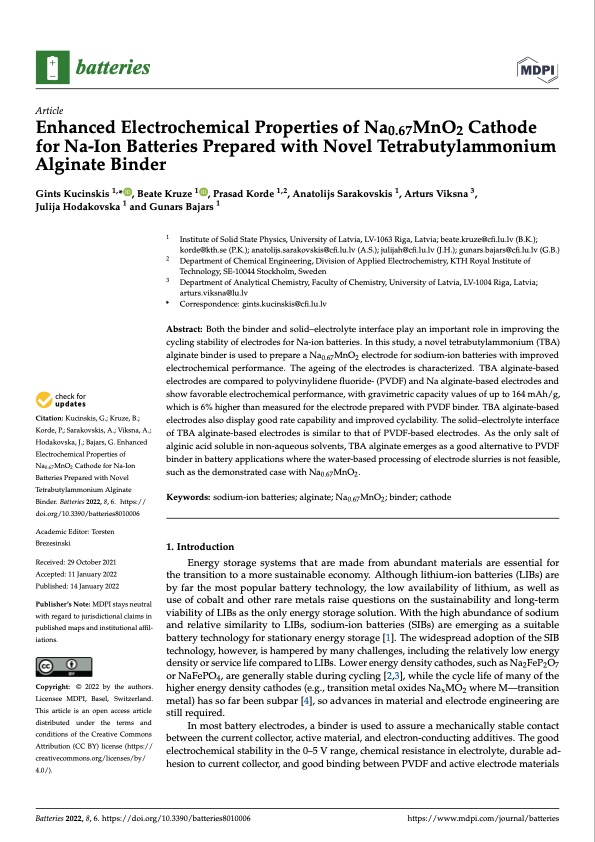
PDF Publication Title:
Text from PDF Page: 001
batteries Article Enhanced Electrochemical Properties of Na0.67MnO2 Cathode for Na-Ion Batteries Prepared with Novel Tetrabutylammonium Alginate Binder Gints Kucinskis 1,* , Beate Kruze 1 , Prasad Korde 1,2, Anatolijs Sarakovskis 1, Arturs Viksna 3, Julija Hodakovska 1 and Gunars Bajars 1 Citation: Kucinskis, G.; Kruze, B.; Korde, P.; Sarakovskis, A.; Viksna, A.; Hodakovska, J.; Bajars, G. Enhanced Electrochemical Properties of Na0.67MnO2 Cathode for Na-Ion Batteries Prepared with Novel Tetrabutylammonium Alginate Binder.Batteries2022,8,6. https:// doi.org/10.3390/batteries8010006 Academic Editor: Torsten Brezesinski Received: 29 October 2021 Accepted: 11 January 2022 Published: 14 January 2022 Publisher’s Note: MDPI stays neutral with regard to jurisdictional claims in published maps and institutional affil- iations. Copyright: © 2022 by the authors. Licensee MDPI, Basel, Switzerland. This article is an open access article distributed under the terms and conditions of the Creative Commons Attribution (CC BY) license (https:// creativecommons.org/licenses/by/ 4.0/). 1 2 Abstract: Both the binder and solid–electrolyte interface play an important role in improving the cycling stability of electrodes for Na-ion batteries. In this study, a novel tetrabutylammonium (TBA) alginate binder is used to prepare a Na0.67MnO2 electrode for sodium-ion batteries with improved electrochemical performance. The ageing of the electrodes is characterized. TBA alginate-based electrodes are compared to polyvinylidene fluoride- (PVDF) and Na alginate-based electrodes and show favorable electrochemical performance, with gravimetric capacity values of up to 164 mAh/g, which is 6% higher than measured for the electrode prepared with PVDF binder. TBA alginate-based electrodes also display good rate capability and improved cyclability. The solid–electrolyte interface of TBA alginate-based electrodes is similar to that of PVDF-based electrodes. As the only salt of alginic acid soluble in non-aqueous solvents, TBA alginate emerges as a good alternative to PVDF binder in battery applications where the water-based processing of electrode slurries is not feasible, such as the demonstrated case with Na0.67MnO2. Keywords: sodium-ion batteries; alginate; Na0.67MnO2; binder; cathode 1. Introduction Energy storage systems that are made from abundant materials are essential for the transition to a more sustainable economy. Although lithium-ion batteries (LIBs) are by far the most popular battery technology, the low availability of lithium, as well as use of cobalt and other rare metals raise questions on the sustainability and long-term viability of LIBs as the only energy storage solution. With the high abundance of sodium and relative similarity to LIBs, sodium-ion batteries (SIBs) are emerging as a suitable battery technology for stationary energy storage [1]. The widespread adoption of the SIB technology, however, is hampered by many challenges, including the relatively low energy density or service life compared to LIBs. Lower energy density cathodes, such as Na2FeP2O7 or NaFePO4, are generally stable during cycling [2,3], while the cycle life of many of the higher energy density cathodes (e.g., transition metal oxides NaxMO2 where M—transition metal) has so far been subpar [4], so advances in material and electrode engineering are still required. In most battery electrodes, a binder is used to assure a mechanically stable contact between the current collector, active material, and electron-conducting additives. The good electrochemical stability in the 0–5 V range, chemical resistance in electrolyte, durable ad- hesion to current collector, and good binding between PVDF and active electrode materials Institute of Solid State Physics, University of Latvia, LV-1063 Riga, Latvia; beate.kruze@cfi.lu.lv (B.K.); korde@kth.se (P.K.); anatolijs.sarakovskis@cfi.lu.lv (A.S.); julijah@cfi.lu.lv (J.H.); gunars.bajars@cfi.lu.lv (G.B.) Department of Chemical Engineering, Division of Applied Electrochemistry, KTH Royal Institute of Technology, SE-10044 Stockholm, Sweden 3 arturs.viksna@lu.lv Department of Analytical Chemistry, Faculty of Chemistry, University of Latvia, LV-1004 Riga, Latvia; * Correspondence: gints.kucinskis@cfi.lu.lv Batteries 2022, 8, 6. https://doi.org/10.3390/batteries8010006 https://www.mdpi.com/journal/batteriesPDF Image | Na-Ion Batteries Tetrabutylammonium Alginate Binder

PDF Search Title:
Na-Ion Batteries Tetrabutylammonium Alginate BinderOriginal File Name Searched:
batteries-08-00006.pdfDIY PDF Search: Google It | Yahoo | Bing
Salgenx Redox Flow Battery Technology: Salt water flow battery technology with low cost and great energy density that can be used for power storage and thermal storage. Let us de-risk your production using our license. Our aqueous flow battery is less cost than Tesla Megapack and available faster. Redox flow battery. No membrane needed like with Vanadium, or Bromine. Salgenx flow battery
| CONTACT TEL: 608-238-6001 Email: greg@salgenx.com | RSS | AMP |